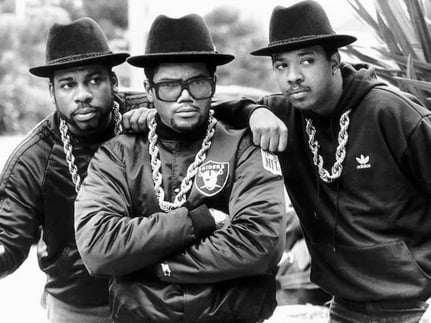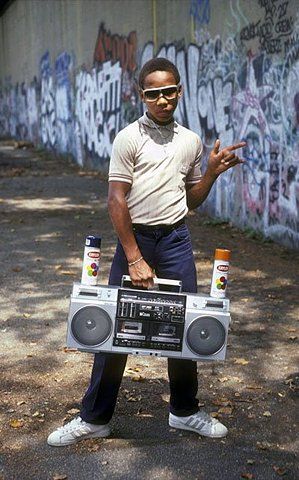The History of Hip Hop in New York: The Birthplace of a Culture That Shook the World
A Spark in the Bronx Ignites a Revolution
Close your eyes and picture it: the South Bronx, 1973, a summer block party pulsing with life. Kids dance on cracked pavement, turntables spin, and a DJ named Kool Herc drops the needle on a funk break, looping the drums into infinity. The crowd erupts. This is no ordinary party—this is the birth of hip hop, a raw, rebellious sound born in New York City’s streets. If you’re a fan vibing to Drake, a producer crafting beats, or an MC spitting bars, you owe it all to this moment. New York didn’t just create hip hop—it forged a culture that’s still shaking the world in 2025. Ready to dive into the legacy? Let’s rewind and ride the rhythm of the city that started it all.
The Four Pillars: How Hip Hop Took Root
Hip hop isn’t just music—it’s a movement with four pillars: DJing, MCing, breakdancing, and graffiti. In the 1970s Bronx, these elements came together like a perfect beat. DJ Kool Herc, the godfather, pioneered the “breakbeat,” isolating drum breaks from James Brown and Funkadelic records to keep dancers—called b-boys and b-girls—moving. At parties in rec rooms like 1520 Sedgwick Avenue, Herc’s Herculoids sound system blasted funk and soul, turning gritty tenements into cultural cauldrons.
Enter the MC. Guys like Coke La Rock grabbed the mic, hyping the crowd with rhymes over Herc’s breaks. These weren’t just party chants—they were the seeds of rap, storytelling that gave voice to a generation ignored by the mainstream. Meanwhile, breakdancers spun on their heads, defying gravity in cyphers at parks and clubs. Graffiti artists like Taki 183 and Phase 2 turned subway cars into canvases, splashing bold tags across the city. By the late ‘70s, hip hop was more than a sound—it was a lifestyle, born from Black and Latino youth reclaiming their space in a city scarred by poverty and neglect.
The Golden Era: From Bronx to Global Stage
By 1979, hip hop broke out of the Bronx with The Sugarhill Gang’s “Rapper’s Delight”, the first rap hit to storm radio. Recorded in Englewood, NJ, but rooted in NYC’s spirit, its funky bassline and playful rhymes hooked the world. Suddenly, labels saw dollar signs, and New York became a rap factory. Grandmaster Flash and the Furious Five dropped “The Message” in 1982, a raw portrait of urban struggle that proved hip hop could be socially conscious. Flash’s turntable wizardry—scratching and cutting—set the DJ standard, while Melle Mel’s rhymes painted the city’s pain.
The ‘80s saw NYC’s hip hop explode. Run-DMC from Queens brought rap to MTV with “Walk This Way,” blending hip hop with rock and rocking Adidas like a uniform. Their label, Def Jam Recordings, founded by Rick Rubin and Russell Simmons, launched stars like LL Cool J and Public Enemy. PE’s It Takes a Nation of Millions to Hold Us Back (1988) was a sonic Molotov, with Chuck D’s revolutionary bars and the Bomb Squad’s chaotic beats. Meanwhile, KRS-One and Boogie Down Productions repped the South Bronx, dropping Criminal Minded (1987), a blueprint for gangsta rap with its gritty tales and boom bap.
Brooklyn joined the fray with Big Daddy Kane, whose slick rhymes and suave style made him a ladies’ man and a lyrical assassin. Queens gave us A Tribe Called Quest, whose People’s Instinctive Travels (1990) blended jazz and conscious rap, proving hip hop could be chill yet profound. The Native Tongues collective, including De La Soul and Jungle Brothers, pushed positivity and Afrocentrism, balancing the genre’s growing edge.
The ‘90s: East Coast Kings and the Rise of Grit
The ‘90s were New York’s golden age, a tug-of-war between lyrical finesse and street rawness. The Notorious B.I.G. ruled Brooklyn, dropping Ready to Die (1994), a cinematic masterpiece of storytelling and flow. His rival, Tupac Shakur, repped the West Coast, but NYC’s Nas countered with Illmatic (1994), a poetic portrait of Queensbridge life that’s still hailed as rap’s holy grail. Jay-Z, another Brooklynite, emerged with Reasonable Doubt (1996), blending hustler tales with polished rhymes, laying the foundation for his empire.
The Wu-Tang Clan, hailing from Staten Island, changed the game with Enter the Wu-Tang (36 Chambers) (1993). RZA’s kung-fu-inspired beats and the group’s nine MCs—each a solo star—created a gritty, mythic sound. Tracks like “C.R.E.A.M.” became anthems, while their business savvy (merch, solo deals) set a blueprint for rap moguls. Meanwhile, Mobb Deep from Queensbridge dropped The Infamous (1995), with Havoc’s haunting beats and Prodigy’s cold bars defining East Coast gangsta rap.
Manhattan’s Bad Boy Records, led by Sean “Puffy” Combs, brought glossy production to the streets. Biggie’s Life After Death (1997) and Mase’s shiny-suit vibes dominated radio, but the East-West rivalry—fueled by media and Bad Boy vs. Death Row—cast a shadow. Biggie’s and Tupac’s murders in 1996-97 left scars, but NYC kept pushing. DMX, from Yonkers, roared onto the scene with It’s Dark and Hell Is Hot (1998), his raw energy and barked delivery reviving hardcore rap.
The 2000s: New York Evolves
The 2000s saw NYC adapt to a changing game. 50 Cent, a Queens native, took over with Get Rich or Die Tryin’ (2003), blending gangsta grit with pop hooks under Dr. Dre and Eminem’s mentorship. His G-Unit crew kept Queens relevant, while The Diplomats (Cam’ron, Juelz Santana) brought Harlem’s flamboyant Dipset swagger. Jay-Z’s The Blueprint (2001), produced by Kanye West and Just Blaze, revived soul-sampled boom bap, proving NYC could innovate.
But the South—led by Atlanta’s trap sound—was rising. NYC’s grip loosened as Lil Wayne and T.I. dominated. Still, artists like Jadakiss and Styles P kept Yonkers’ LOX crew gritty, and Talib Kweli and Mos Def carried the torch for conscious rap. By the late 2000s, Nicki Minaj from Queens emerged, blending rap, pop, and theater with Pink Friday (2010), redefining female MCs.
2010s to 2025: The New Wave and Beyond
The 2010s brought a new guard. A$AP Rocky and the A$AP Mob infused Harlem with fashion and trap, with Live.Love.A$AP (2011) blending cloud rap and Southern influences. Brooklyn’s Joey Bada$$ revived ‘90s boom bap with 1999 (2012), while Flatbush Zombies mixed psychedelic vibes with grit. The Bronx’s Cardi B exploded with Invasion of Privacy (2018), her unapologetic flow and hustle making her a global star.
Drill, born in Chicago, found a home in Brooklyn with Pop Smoke, whose Welcome to the Party (2019) and Meet the Woo redefined NYC’s sound with deep-voiced flows and UK-inspired beats. Pop’s tragic death in 2020 didn’t stop drill’s rise, carried by Fivio Foreign and Sheff G. Meanwhile, Westside Gunn, Benny the Butcher, and Conway the Machine from Buffalo (upstate NY) brought grimy lyricism back with Griselda Records, channeling Wu-Tang’s raw aesthetic.
In 2025, NYC’s hip hop is a melting pot. Ice Spice, from the Bronx, rules with her drill-infused pop-rap, while Lil Tjay keeps melodic trap alive. Veterans like Nas and Jay-Z still drop gems, and producers like Harry Fraud and The Alchemist craft timeless beats. From Coachella to SoundCloud, New York’s influence endures, blending its golden-era roots with global sounds like Afrobeat and Latin trap.
Why New York’s Legacy Matters
New York didn’t just birth hip hop—it gave the world a voice. From Kool Herc’s breakbeats to Pop Smoke’s woo, the city’s boroughs turned struggle into art, creating a culture that’s now a billion-dollar industry. For fans, it’s the sound of rebellion and pride. For producers, it’s a toolbox of techniques—sampling, scratching, boom bap, drill. For MCs, it’s a legacy of lyricism and hustle. Every 808 kick, every tagged train, every cypher owes a nod to NYC.
Once Upon A Time In New York: The Birth Of Hip Hop, Disco & Punk




The History of Hip Hop in New York
Explore the history of hip hop in New York, from Kool Herc to Pop Smoke. Discover why NYC is the culture’s heartbeat! #NYCHipHop #HipHop
5/4/202511 min read
A Spark in the Bronx Ignites a Revolution
Close your eyes and picture it: the South Bronx, 1973, a summer block party pulsing with life. Kids dance on cracked pavement, turntables spin, and a DJ named Kool Herc drops the needle on a funk break, looping the drums into infinity. The crowd erupts. This is no ordinary party—this is the birth of hip hop, a raw, rebellious sound born in New York City’s streets. If you’re a fan vibing to Drake, a producer crafting beats, or an MC spitting bars, you owe it all to this moment. New York didn’t just create hip hop—it forged a culture that’s still shaking the world in 2025. Ready to dive into the legacy? Let’s rewind and ride the rhythm of the city that started it all.
The Four Pillars: How Hip Hop Took Root
Hip hop isn’t just music—it’s a movement with four pillars: DJing, MCing, breakdancing, and graffiti. In the 1970s Bronx, these elements came together like a perfect beat. DJ Kool Herc, the godfather, pioneered the “breakbeat,” isolating drum breaks from James Brown and Funkadelic records to keep dancers—called b-boys and b-girls—moving. At parties in rec rooms like 1520 Sedgwick Avenue, Herc’s Herculoids sound system blasted funk and soul, turning gritty tenements into cultural cauldrons.
Enter the MC. Guys like Coke La Rock grabbed the mic, hyping the crowd with rhymes over Herc’s breaks. These weren’t just party chants—they were the seeds of rap, storytelling that gave voice to a generation ignored by the mainstream. Meanwhile, breakdancers spun on their heads, defying gravity in cyphers at parks and clubs. Graffiti artists like Taki 183 and Phase 2 turned subway cars into canvases, splashing bold tags across the city. By the late ‘70s, hip hop was more than a sound—it was a lifestyle, born from Black and Latino youth reclaiming their space in a city scarred by poverty and neglect
The History of Hip Hop in New York: The Birthplace of a Culture That Shook the World
The Golden Era: From Bronx to Global Stage
By 1979, hip hop broke out of the Bronx with The Sugarhill Gang’s “Rapper’s Delight”, the first rap hit to storm radio. Recorded in Englewood, NJ, but rooted in NYC’s spirit, its funky bassline and playful rhymes hooked the world. Suddenly, labels saw dollar signs, and New York became a rap factory. Grandmaster Flash and the Furious Five dropped “The Message” in 1982, a raw portrait of urban struggle that proved hip hop could be socially conscious. Flash’s turntable wizardry—scratching and cutting—set the DJ standard, while Melle Mel’s rhymes painted the city’s pain.
The ‘80s saw NYC’s hip hop explode. Run-DMC from Queens brought rap to MTV with “Walk This Way,” blending hip hop with rock and rocking Adidas like a uniform. Their label, Def Jam Recordings, founded by Rick Rubin and Russell Simmons, launched stars like LL Cool J and Public Enemy. PE’s It Takes a Nation of Millions to Hold Us Back (1988) was a sonic Molotov, with Chuck D’s revolutionary bars and the Bomb Squad’s chaotic beats. Meanwhile, KRS-One and Boogie Down Productions repped the South Bronx, dropping Criminal Minded (1987), a blueprint for gangsta rap with its gritty tales and boom bap.
Brooklyn joined the fray with Big Daddy Kane, whose slick rhymes and suave style made him a ladies’ man and a lyrical assassin. Queens gave us A Tribe Called Quest, whose People’s Instinctive Travels (1990) blended jazz and conscious rap, proving hip hop could be chill yet profound. The Native Tongues collective, including De La Soul and Jungle Brothers, pushed positivity and Afrocentrism, balancing the genre’s growing edge.
The ‘90s: East Coast Kings and the Rise of Grit
The ‘90s were New York’s golden age, a tug-of-war between lyrical finesse and street rawness. The Notorious B.I.G. ruled Brooklyn, dropping Ready to Die (1994), a cinematic masterpiece of storytelling and flow. His rival, Tupac Shakur, repped the West Coast, but NYC’s Nas countered with Illmatic (1994), a poetic portrait of Queensbridge life that’s still hailed as rap’s holy grail. Jay-Z, another Brooklynite, emerged with Reasonable Doubt (1996), blending hustler tales with polished rhymes, laying the foundation for his empire.
The Wu-Tang Clan, hailing from Staten Island, changed the game with Enter the Wu-Tang (36 Chambers) (1993). RZA’s kung-fu-inspired beats and the group’s nine MCs—each a solo star—created a gritty, mythic sound. Tracks like “C.R.E.A.M.” became anthems, while their business savvy (merch, solo deals) set a blueprint for rap moguls. Meanwhile, Mobb Deep from Queensbridge dropped The Infamous (1995), with Havoc’s haunting beats and Prodigy’s cold bars defining East Coast gangsta rap.
Manhattan’s Bad Boy Records, led by Sean “Puffy” Combs, brought glossy production to the streets. Biggie’s Life After Death (1997) and Mase’s shiny-suit vibes dominated radio, but the East-West rivalry—fueled by media and Bad Boy vs. Death Row—cast a shadow. Biggie’s and Tupac’s murders in 1996-97 left scars, but NYC kept pushing. DMX, from Yonkers, roared onto the scene with It’s Dark and Hell Is Hot (1998), his raw energy and barked delivery reviving hardcore rap.
The 2000s: New York Evolves
The 2000s saw NYC adapt to a changing game. 50 Cent, a Queens native, took over with Get Rich or Die Tryin’ (2003), blending gangsta grit with pop hooks under Dr. Dre and Eminem’s mentorship. His G-Unit crew kept Queens relevant, while The Diplomats (Cam’ron, Juelz Santana) brought Harlem’s flamboyant Dipset swagger. Jay-Z’s The Blueprint (2001), produced by Kanye West and Just Blaze, revived soul-sampled boom bap, proving NYC could innovate.
But the South—led by Atlanta’s trap sound—was rising. NYC’s grip loosened as Lil Wayne and T.I. dominated. Still, artists like Jadakiss and Styles P kept Yonkers’ LOX crew gritty, and Talib Kweli and Mos Def carried the torch for conscious rap. By the late 2000s, Nicki Minaj from Queens emerged, blending rap, pop, and theater with Pink Friday (2010), redefining female MCs.
2010s to 2025: The New Wave and Beyond
The 2010s brought a new guard. A$AP Rocky and the A$AP Mob infused Harlem with fashion and trap, with Live.Love.A$AP (2011) blending cloud rap and Southern influences. Brooklyn’s Joey Bada$$ revived ‘90s boom bap with 1999 (2012), while Flatbush Zombies mixed psychedelic vibes with grit. The Bronx’s Cardi B exploded with Invasion of Privacy (2018), her unapologetic flow and hustle making her a global star.
Drill, born in Chicago, found a home in Brooklyn with Pop Smoke, whose Welcome to the Party (2019) and Meet the Woo redefined NYC’s sound with deep-voiced flows and UK-inspired beats. Pop’s tragic death in 2020 didn’t stop drill’s rise, carried by Fivio Foreign and Sheff G. Meanwhile, Westside Gunn, Benny the Butcher, and Conway the Machine from Buffalo (upstate NY) brought grimy lyricism back with Griselda Records, channeling Wu-Tang’s raw aesthetic.
In 2025, NYC’s hip hop is a melting pot. Ice Spice, from the Bronx, rules with her drill-infused pop-rap, while Lil Tjay keeps melodic trap alive. Veterans like Nas and Jay-Z still drop gems, and producers like Harry Fraud and The Alchemist craft timeless beats. From Coachella to SoundCloud, New York’s influence endures, blending its golden-era roots with global sounds like Afrobeat and Latin trap.
Why New York’s Legacy Matters
New York didn’t just birth hip hop—it gave the world a voice. From Kool Herc’s breakbeats to Pop Smoke’s woo, the city’s boroughs turned struggle into art, creating a culture that’s now a billion-dollar industry. For fans, it’s the sound of rebellion and pride. For producers, it’s a toolbox of techniques—sampling, scratching, boom bap, drill. For MCs, it’s a legacy of lyricism and hustle. Every 808 kick, every tagged train, every cypher owes a nod to NYC.
Once Upon A Time In New York: The Birth Of Hip Hop, Disco & Punk






